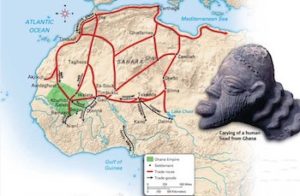
*The Ghanaian Empire is celebrated on this date in 830. Known as Wagadou (Ghana being the title of its ruler) Empire, it was a West African kingdom in present-day southeastern Mauritania and western Mali.
The origins of the Ghanaian Empire have been disputed between ethnohistoric accounts and archaeological interpretations. The earliest discussions of its roots are in the Sudanese chronicles of Mahmud Kati and Abd al-Rahman as-Sadi. According to Kati's Tarikh al-Fettash, in a section probably composed by the author around 1580 but citing the authority of the chief judge of Messina, Ida al-Massini, who lived somewhat earlier, twenty kings ruled Ghana before the advent of the Prophet Muhammad, and the empire extended until the century after the Prophet. In addressing the rulers' origin, the Tarikh al-Fettash provides three different opinions: that they were Soninke, Wangara, or Sanhaja Berbers.
While the 16th-century versions of genealogies might have linked Ghana to the Sanhaja, earlier versions, for example, as reported by the 11th-century writer al-Idrisi and the 13th-century writer ibn Said, noted that rulers of Ghana in those days traced their descent from the clan of the Prophet Muhammad either through his protector Abi Talib or through his son-in-law Ali. He says that 22 kings ruled before the Hijra and 22 after.
While these early views led to many exotic interpretations of a foreign origin of Wagadu, these views are generally disregarded by scholars. Levtzion and Spaulding, for example, argue that al-Idrisi's testimony should be looked at critically due to demonstrably gross miscalculations in geography and historical chronology. At the same time, they associate Ghana with the local Soninke. In addition, the archaeologist and historian Raymond Mauny argues that al-Kati's and al-Saadi's views of a foreign origin cannot be regarded as reliable.
He argues that the interpretations were based on the later presence (after Ghana's demise) of nomadic interlopers, on the assumption that they were the historic ruling caste, and that the writers did not adequately consider contemporary accounts such as those of Ya'qubi (872 CE), al-Masudi (c. 944 CE), Ibn Hawqal (c. 977 CE), and al-Biruni (c. 1036 CE), as well as al-Bakri, all of whom describe the population and rulers of Ghana as "negroes". Complex societies based on trans-Saharan trade in salt and gold had existed in the region since ancient times. Still, introducing the camel to the western Sahara in the 3rd century CE opened the way to significant changes in the area that became the Ghana Empire.
By the time of the Muslim conquest of North Africa in the 7th century, the camel had changed the ancient, more irregular trade routes into a trade network from Morocco to the Niger River. The Ghana Empire grew rich from this increased trans-Saharan trade in gold and salt, allowing larger urban centers to develop. The traffic furthermore encouraged territorial expansion to gain control over the different trade routes. When Ghana's ruling dynasty began, it remained uncertain.
It is mentioned for the first time in written records by Muḥammad ibn Mūsā al-Khwārizmī in 830. In the 11th century, the Cordoban scholar Al-Bakri traveled to the region and detailed the kingdom. As the empire declined c. 1100, it finally became a vassal of the rising Mali Empire at some point in the 13th century. When, in 1957, the Gold Coast became the first country in sub-Saharan Africa to gain its independence from colonial rule, it renamed itself Ghana in honor of the long-gone empire.